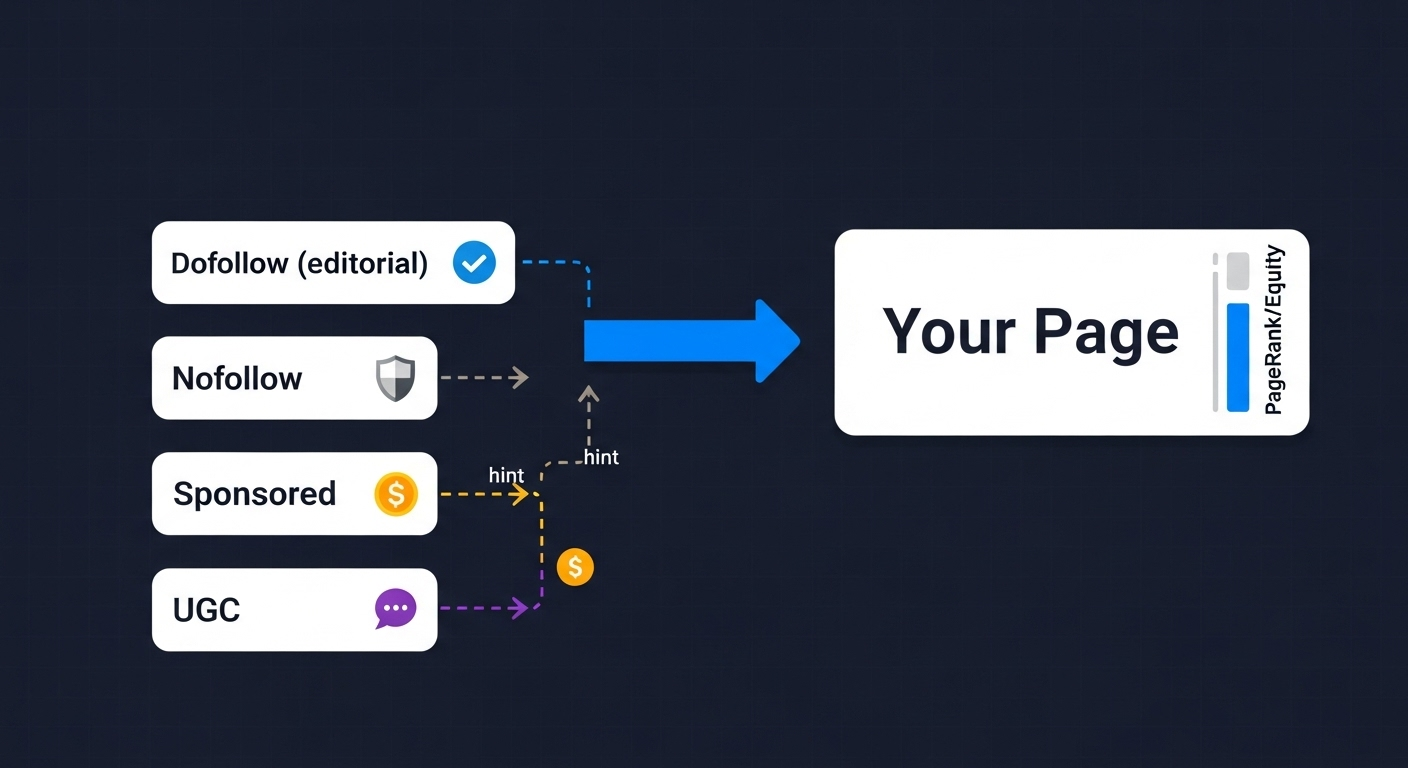What Is a Dofollow Link? Why SEOs Obsess Over It
Beginner-friendly guide to dofollow vs. nofollow links, how PageRank flows, and when each rel attribute matters so you can build safer, stronger backlinks.

If you’re learning link building, one of the first questions you’ll ask is simple: what is a dofollow link? This phrase dominates SEO discussions because dofollow backlinks are the type that usually pass PageRank and help a site rank higher.
Here’s the catch: there’s no such thing as an actual dofollow HTML tag. A “dofollow” link is just shorthand for a standard link without restrictive attributes.
TL;DR
- A dofollow link is simply a standard link that search engines can crawl and count as a ranking signal.
- Links marked with
rel="nofollow",rel="sponsored", orrel="ugc"are considered differently and less likely to pass link equity. - Dofollow backlinks typically help SEO by passing PageRank and topical relevance.
- A natural backlink profile mixes dofollow and nofollow links.
- Always pursue high‑quality, relevant backlinks instead of chasing quantity.
- You want to monitor dofollow links as the lose of them might impact your search engine ranking negatively. We recommend BacklinkDog.
What “Dofollow” Really Means
In HTML, a normal backlink looks like this:
<a href="https://example.com/your-page">Example anchor text</a>
That’s a dofollow backlink — a standard link with no restrictive rel values. Search engines like Google can crawl it, pass PageRank, and consider it a signal of trust.
The rel Attribute
You can change how search engines treat a link by using the rel attribute:
<a href="https://example.com/your-page" rel="nofollow">Anchor</a>
<a href="https://example.com/your-page" rel="sponsored">Anchor</a>
<a href="https://example.com/your-page" rel="ugc">Anchor</a>
nofollow: Suggests Google should not pass ranking signals.sponsored: Used for paid or affiliate links.ugc: Identifies user‑generated content like forum posts or blog comments.
In other words, unless you see one of these values, you’re looking at a dofollow link.
Why SEOs Want Dofollow Backlinks
Dofollow backlinks remain one of the most powerful SEO ranking factors. A relevant, trusted dofollow link helps:
- Improve organic rankings for target keywords.
- Transfer topical authority via anchor text and surrounding content.
- Send direct referral traffic, which has business value independent of SEO.
But not all dofollow links are equal: a contextual backlink from a trusted site in your niche is worth far more than dozens of low‑quality directory submissions.
Dofollow vs. Nofollow vs. Sponsored vs. UGC
| Link type | How it looks | Typical use case | Passes SEO value? |
|---|---|---|---|
| Dofollow | <a href="url">text</a> | Editorial content | Often yes |
| Nofollow | rel="nofollow" | Untrusted links, ads | Usually no |
| Sponsored | rel="sponsored" | Paid/affiliate placement | Usually no |
| UGC | rel="ugc" | Blog comments, forums | Usually no |
Don’t Chase 100% Dofollow
A natural link profile contains both nofollow and dofollow links. Only pursuing “dofollow links” can look manipulative and invite algorithmic or manual action.
How To Check If a Link Is Dofollow
- Inspect the page’s HTML with browser dev tools.
- Find the anchor tag pointing to your domain.
- If you see no
rel="nofollow",rel="sponsored", orrel="ugc", you’ve got a dofollow backlink.
Or use a backlink monitoring tool like BacklinkDog to track:
- Whether your backlinks are dofollow or nofollow.
- If publishers change a dofollow link to nofollow later.
- Whether a backlink gets removed entirely.
How To Get More Dofollow Backlinks
Safe, white‑hat methods to earn dofollow links for SEO include:
- Publishing linkable assets (tools, templates, research).
- Reaching out to editors for niche‑relevant inclusion in resource pages.
- Guest posting on reputable sites.
- Providing expert quotes or data for journalists.
- Building partnerships within your industry.
Most importantly: always prioritize relevance and credibility over chasing “easy” backlinks.
Common Dofollow Link Myths
- Myth: “Nofollow is worthless.” Truth: nofollow links still bring referral traffic and exposure.
- Myth: “All dofollow links are good.” Truth: spammy dofollow backlinks can trigger penalties.
- Myth: “Every link should be dofollow.” Truth: a natural mix of dofollow and nofollow looks safer.
FAQ on Dofollow Links
Do dofollow backlinks always improve SEO?
Not automatically, but high‑quality ones from relevant domains significantly increase your ranking power.
Can I ask webmasters to switch nofollow to dofollow?
Only if the link is truly editorial. Never pressure publishers to violate Google’s guidelines.
Are free dofollow backlinks safe?
If they come from spammy directories or link farms, no. Only editorially earned dofollow links are safe long‑term.
Bottom Line
A dofollow backlink is just a standard editorial link. It matters because it can pass PageRank and authority — but the source, context, and relevance matter even more than the dofollow tag itself.
For sustainable SEO, focus on earning high‑quality dofollow links naturally while monitoring your entire backlink profile with a tool like BacklinkDog to detect changes and protect your efforts.
Start Monitoring Your Backlinks Today
Don't wait for broken links to hurt your SEO. BacklinkDog monitors your backlinks 24/7 and sends instant alerts when issues arise, so you can fix them before they impact your rankings.
Get started


